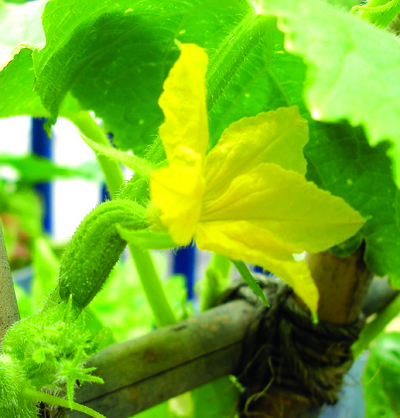 A guide to helping cucumbers and melons get their groove on
A guide to helping cucumbers and melons get their groove on
by Char Vandermeer
If summer were a taste, it would surely be cucumber—or maybe muskmelon. They’re both little bursts of sunshine on the vine. While your planting space may be limited to a few pots or a tiny patch in a community garden, that doesn’t mean your taste buds should go unfulfilled. Philly may prove to be a tough habitat for these fussy vines, but that just means they’ll require some extra attention.
May and June’s warmer days and nights provide the perfect conditions for growing cucurbits, a family of plants that includes cucumbers and melons. Grab a five-gallon bucket, drill a few holes in the bottom and dump in some nice, fluffy soil that’s rich in organic matter—add some compost to the soil if you can.
Shove a trellis into the container for the emerging vines to climb, drop in a couple of seeds (your goal is one, maybe two, plants per bucket) and you’re off to a good start.
Sometimes, Mother Nature needs some help. Unlike tomatoes and beans, which are self-pollinators, cucurbits rely exclusively on bees to ensure a healthy harvest. While it’s a good idea to plant a few bright flowers among your vegetables to attract bees, you may still need to do the deed yourself.
Insufficient pollination leads to a vastly reduced crop and misshapen fruits. If the bees aren’t buzzing, hand pollination is an easy and satisfying solution to the problem. First you’ll need to identify the male and female flowers. Fortunately, female cucumbers are easily recognized by the miniature cucumber swelling behind the flower; male flowers grow directly from the vine and will outnumber your female blooms substantially. Typically, male flowers appear first. Don’t worry—just be patient and eventually your vine will be brimming with both.
Once you’ve found your lucky ladies, grab a small paintbrush and gently gather pollen from the anthers of the male flowers by dabbing or twirling the brush inside the bloom. The tip of the brush should have visible yellow pollen on it—I find black brushes show the pollen best. Then, carefully dab the collected pollen onto the pistils inside the female flower. After the female bloom has been successfully fertilized, the flower will fall off and the fruit will mature.
Like most vegetables, cucumbers and melons need a full six to eight hours of sun each day. They’re thirsty buggers, too, so make sure you keep the soil good and moist.



